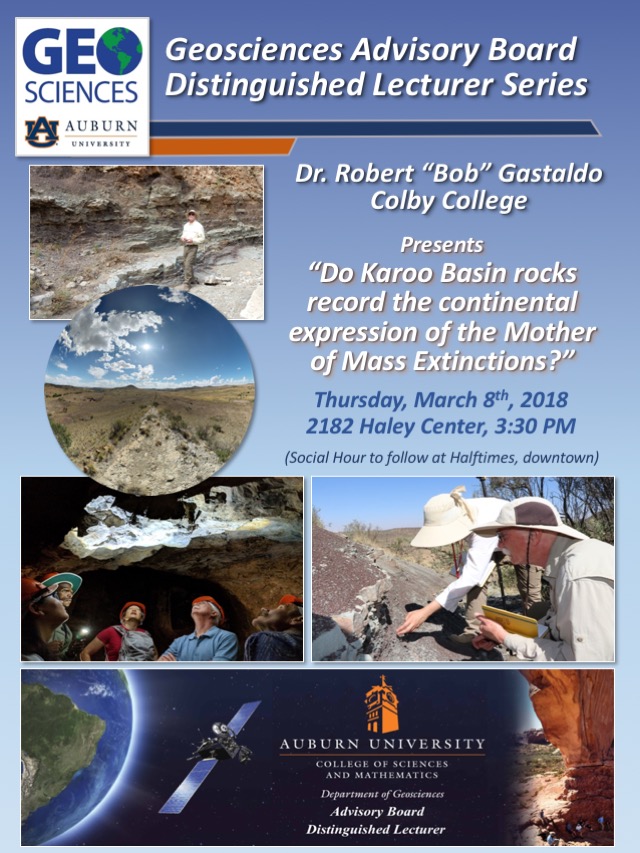COSAM News Articles 2018 February Do Karoo Basin rocks record the continental expression of the Mother of Mass Extinction?
Do Karoo Basin rocks record the continental expression of the Mother of Mass Extinction?
Robert A. Gastaldo, Whipple-Coddington Professor of Geology, Colby College, 5807 Mayflower Hill Drive, Waterville, ME 04901-5807, ragastal@colby.edu
Current models of the terrestrial biosphere’s response to the end-Permian crisis are based largely on lithostratigraphic, magnetostratigraphic, and biostratigraphic records obtained from sedimentary successions in the Karoo Basin, South Africa. These successions have been interpreted to represent continuous sedimentation across the upper Daptocephalus (latest Permian) and lower Lystrosaurus (earliest Triassic) vertebrate-assemblage zones, assigned to the Elandsberg Mbr. and lower Palingkloof Mbr., and upper Palingkloof Mbr. and overlying Katberg Fm., respectively. The stratigraphic section at Old (West) Lootsberg Pass, Eastern Cape Province, is used as a cornerstone for the currently accepted model correlated with the marine extinction event, in part, based on a magnetic polarity stratigraphy of limited documentation. A multidisciplinary effort provides a refined stratigraphic framework, encompassing over 740 m of measured section, compiled from twelve, closely spaced and physically correlated localities, across a northwest to southeast distance of less than 2 km. This framework is placed into magnetostratigraphic context and constrained by two U-Pb ID-TIMS age dates.
The Old Lootsberg Pass succession does not record continuous sedimentation, as previously argued. Rather, the presence of several intraformational pedogenic-nodule conglomerate-lag deposits, a character used by other workers as diagnostic the post-extinction Katberg Formation, occur in the Elandsberg Member 100 m stratigraphically below the Katberg Formation. An interlaminated lithofacies, previously used as a diagnostic feature of the terrestrial event, occurs isolated at several stratigraphic positions, indicating that it is neither unique nor mappable. A dominant signature of normal-polarity magnetozones in the section is interrupted by two, short reverse-polarity interval which are restricted to siltstone beneath erosional contacts with fluvial sandstones, indicating their cryptic nature in the succession. In addition, we recently report a Wuchiapingian maximum-age estimate for a detrital zircon population from a bed stratigraphically above a previously reported Early Changhsingian age estimate for these rocks. A comparison of the sedimentologic features of these deposits reveals that the bed from which the Changhsingian age is derived supports an ashfall interpretation rather than a reworked deposit from which the Wuchiapingian depositional age is derived. A synthesis of our observations from Old (West) Lootsberg Pass with global patterns reported from the marine realm leads to the conclusion that the turnover from the Daptocephalus to Lystrosaurus AZs is not coincident with the end-Permian marine event.
Latest Headlines
-
02/12/2025
-
02/11/2025
-
02/10/2025
-
01/30/2025
-
12/03/2024

